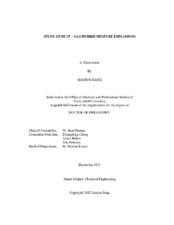| dc.description.abstract | Hybrid mixtures are widely encountered in industries such as coal mines, paint factories, pharmaceutical industries, or grain elevators. Hybrid mixtures explosions involving dust and gas can cause great loss of lives and properties. The lower flammability limit (LFL) is a critical parameter when conducting a hazard assessment or developing mitigation methods for processes involving hybrid mixtures. Unlike unitary dust or gas explosions, which have been widely studied in past decades, only minimal research focuses on hybrid mixtures, and data concerning hybrid mixtures can rarely be found. Although methods to predict the LFL have been developed by using either Le Chatelier’s Law, which was initially proposed for homogeneous gas mixtures, or the Bartknecht curve, which was adopted for only certain hybrid mixtures, significant deviations still remain. A more accurate correlation to predict an LFL for a hybrid mixtures explosion is necessary for risk assessment. This work focuses on the study of hybrid mixtures explosions in a 36 L dust explosion apparatus including mixtures of methane/niacin, methane/cornstarch, ethane/niacin and ethylene/niacin in air. By utilizing basic characteristics of unitary dust or gas explosions, a new formula is proposed to improve the prediction of the LFL of the mixture. The new formula is consistent with Le Chatelier’s Law.
This work also studied the effect of varying the ignition energy and turbulence intensity to the proposed formula. For ignition energy effect, results from methane/niacin mixture demonstrated that the MEC and LFL will not be affected by changing ignition energy. There is no distinguishable difference among gas explosion index (KG) and dust explosion index (KSt) derived from tests with every ignition energy (2.5 kJ, 5 kJ and 10 kJ) in a 36 L vessel. The proposed formula is independent of ignition energy. For turbulence effect, the proposed formula can have a good prediction of the explosion and non-explosion zone if the ignition delay time is within a certain range. The formula prediction is good as the ignition delay time increases up to 100 ms in this work. Propane/niacin and propane/cornstarch mixtures are also tested to validate the proposed formula. It has been confirmed that the proposed formula predicts the explosion and non-explosion zone boundary of such mixtures. | en |


